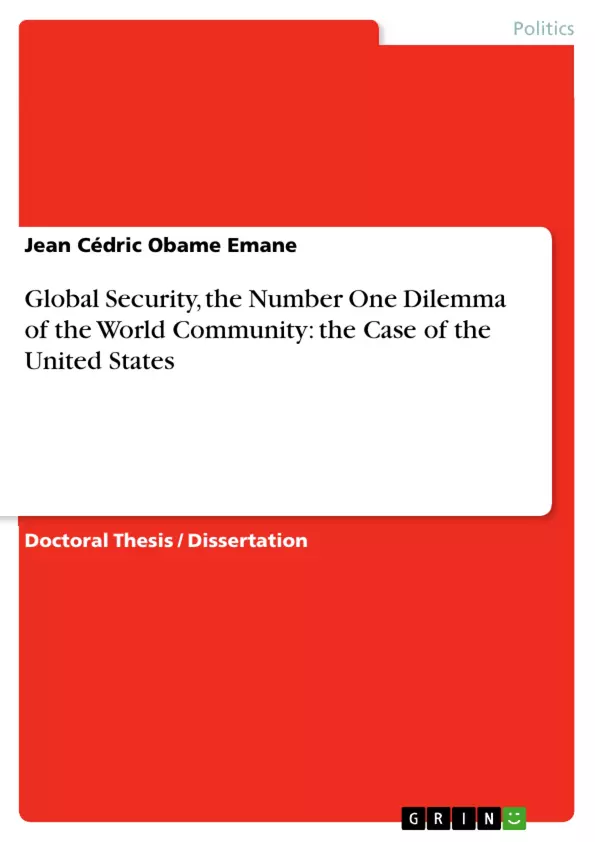This paper is an attempt to deconstruct the concept of security which has been by tradition exclusively confined to the military realm. We make evident that security takes into consideration a number of fields and that its major concern is the human person. In addressing security in this work, we do not only refer to the security of states – the concept of national security –, but also to that of individuals – human security –.Governments should integrate in their security agendas not only their own security, but also the security of their nationals. Accordingly, this implies that they should protect their citizens against any threat to human life. In other words, governments or the people they rule do not merely face military threats from other states; they are as well endangered by other threats to their security, these threats are debated in this research paper. We do not mean that military issues are not to be conceptualized within security frameworks, but we do contend that they are not the unique issues to be securitized. Indeed, this paper displays that other issues should be securitized.
TABLE OF CONTENTS
- PART I
- INTRODUCTION
- ARMAMENT AND DISARMAMENT
- ARMAMENT AND DISARMAMENT IN THE 20TH AND 21ST CENTURIES
- World Military Expenditure and Nuclear Armament
- Early Approaches to Disarmament and Humanitarian Law of War
- Practical Obstacles to Nuclear Disarmament
- ARMAMENT AND DISARMAMENT IN THE 20TH AND 21ST CENTURIES
- NUCLEAR SECURITY
- Weapons of Mass Destruction and International Law
- Nuclear Terrorism: Fighting and Identifying the Threat
- Between Intergovernmental Cooperation and Catastrophe
- Japan's Self Defense: the Issue of Nuclear Breakout
- PART II
- ENVIRONMENTAL SECURITY
- ENVIRONMENTAL THREATS TO HUMAN SECURITY
- The Rise of Environmental Issues in Global Politics
- Environmental Issues as Threats to Security and Reasons for Environmental Problems
- Assessing Environmental Security
- Global Environmental Change and Human Security
- ENVIRONMENTAL THREATS TO HUMAN SECURITY
- NATURAL THREATS TO HUMAN SECURITY
- Natural Catastrophes, Population Pressures and Demand for Resources
- Water Shortage and Global Water Problems
- FRAGMENTATION OF INTERNATIONAL ENVIRONMENTAL LAW AND THE SYNERGY
- Ad Hoc Approach to the Creation of MEAs and their Outcomes
- The Longstanding Fragmented Chemical Regulation Regime
- The Synergy Approach to MEAS
- Creating the Synergy
- The Synergy: the Solution to Fragmentation
- ENVIRONMENTAL SECURITY
- PART III
- SECURITY THREATS TO STATES AND REGIONAL SECURITY
- SECURITIZATION
- The Concept of Security
- Broad and Restricted Conceptualization of Security
- The Expanding of Security
- MILITARY THREATS TO SECURITY FROM STATES
- Ideological Geopolitics (the Cold War) and the New World Order
- Collective Security
- NONVIABLE STATES, A MAJOR ROOT OF CONFLICT TODAY
- Microstates and the Issue of Non-viability
- Socioeconomic Viability
- Military Viability
- Political Viability
- REGIONAL SECURITY
- Regionalism: Historical Overview
- The Current Challenges of Regionalism
- SECURITIZATION
- SECURITY THREATS TO STATES AND REGIONAL SECURITY
OBJECTIVES AND KEY THEMES
This thesis seeks to expand the traditional definition of security beyond the military realm and explore its application to various fields, particularly human security. It examines the interconnectedness of various security concerns, including environmental threats, natural disasters, and the challenges posed by nonviable states.
- The broadening of security beyond military concerns
- The importance of human security and its impact on state security
- Environmental threats and their implications for global security
- The challenges posed by nonviable states and their impact on regional stability
- The need for a comprehensive approach to security that encompasses various threats and actors
CHAPTER SUMMARIES
The thesis is divided into three parts, each exploring different aspects of security.
- Part I: Introduction to Armament and Disarmament, and Nuclear Security
- Chapter 1: Provides a historical overview of armament and disarmament, analyzing the role of military expenditure and nuclear weapons. It also discusses early approaches to disarmament and the development of humanitarian law.
- Chapter 2: Focuses on nuclear security, examining the legal framework for weapons of mass destruction, the threat of nuclear terrorism, and the challenges of intergovernmental cooperation.
- Part II: Environmental and Natural Threats to Human Security
- Chapter 3: Examines the rise of environmental issues as threats to security, highlighting their impact on human well-being and the need for global action. It explores the role of international environmental law in addressing these challenges.
- Chapter 4: Explores the impact of natural threats, such as natural disasters, population pressures, and water shortages, on human security. It analyzes the relationship between these threats and global resource scarcity.
- Part III: Security Threats to States and Regional Security
- Chapter 6: Discusses the concept of security, analyzing different interpretations and their implications for policymaking. It examines the broadening of the security agenda to include non-military threats.
- Chapter 7: Focuses on military threats to security from states, exploring the impact of ideological conflicts like the Cold War and the emergence of a new world order.
- Chapter 8: Explores the challenges posed by nonviable states, analyzing their socioeconomic, military, and political vulnerabilities and their potential for conflict.
- Chapter 9: Examines the role of regionalism in addressing security challenges, highlighting both its potential benefits and its limitations.
KEYWORDS
The thesis focuses on global security, human security, environmental security, nuclear security, disarmament, nonviable states, regional security, and the challenges of securitization.
- Quote paper
- Jean Cédric Obame Emane (Author), 2018, Global Security, the Number One Dilemma of the World Community: the Case of the United States, Munich, GRIN Verlag, https://www.grin.com/document/387541



